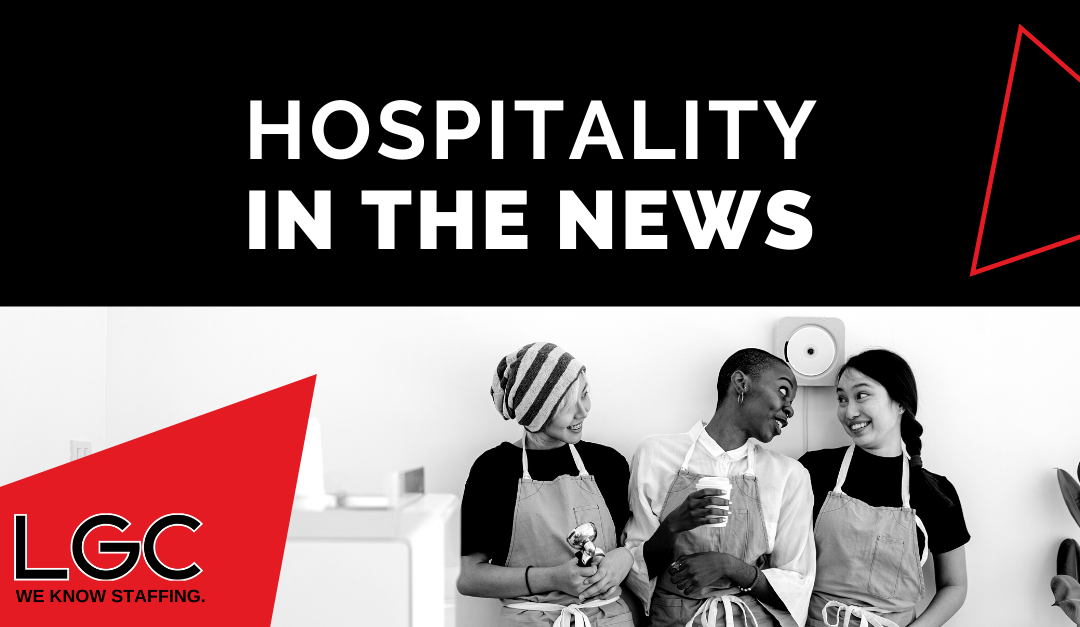Every week we comb through the news to find employment trends affecting the hospitality industry so you don’t have to. This week’s Hospitality in the News topic: how to maintain great customer service while leveraging hospitality technology.
As consumers’ needs evolve, hospitality technology has become more prevalent to better enhance the guest experience and improve standard operating procedures. Restaurants ranging from fine dining to fast food have begun utilizing various tech platforms – some even going as far as entering the metaverse. (The metaverse refers to virtual reality with a focus on social connection.)
You can also expect to see hotels leveraging hospitality technology to simplify some of their processes – but we anticipate it to be less frequent than a restaurant would so the guest experience doesn’t change too much. Somewhere you can definitely expect to see hospitality tech updates are at stadiums and concession stands. When attending a major sporting event, it’s likely that you’ll be going cashless and more businesses have begun following suit.
For years, the concern surrounding the rise of artificial intelligence in restaurants was that it would take the place of crucial roles in the hospitality industry. But considering that there are still over one million open jobs in leisure and hospitality (according to the Bureau of Labor Statistics), it only makes sense that some of these jobs would be outsourced to technology.
The following are some of the processes that are more commonly delegated to hospitality technology platforms:
- Making reservations
- Food ordering
- Bill payment
- Food + beverage menus
Now that most people (80%) are back to being comfortable dining in a restaurant, we better understand just how important the overall guest experience is. From online delivery to take out to on-site dining, consumers want an experience that will keep them coming back for more. But with the rise of hospitality technology, more human jobs are being replaced – so how can you ensure guests are having the right experience?
How to Maintain Great Customer Service While Leveraging Hospitality Technology
Before learning how to maintain great customer service, it’s crucial to identify what positions or responsibilities are being delegated to the tech. Then decide how the consumer will be impacted by that change. For example, if your restaurant has a self-order kiosk, guests are less likely to ask questions about menu items, upsell based on recommendations, etc. This impacts both the restaurant and the customer.
Another example are QR codes and contactless payments. An advancement that simplifies routine processes like menu ordering and pay – but removes the element of human touch. And if consumers are choosing to dine out, fully digitalizing the process may be a turn off. (Otherwise they could opt for delivery or take out.)
Now that we understand practical examples of how hospitality tech may impact the guest experience, we can discuss how to maintain great customer service:
Hire for soft skills
Since some responsibilities will be removed from your employees, technical experience may not be a requirement for some positions. If you have a platform that manages reservations and seating, hosts may not need to have previous restaurant or hotel experience. Rather, it’s more important for them to communicate well, be friendly and personable, and other relevant soft skills that make them the right person to greet incoming guests.
Similar for servers. QR codes and contactless payments mean more efficient processes, but it also means less opportunities for guests to connect with the staff. Building that connection is vital to creating a memorable experience. That’s why prioritizing the necessary soft skills can be the difference between an average experience and a great one.
Prioritize table touches
If you’re not familiar, a table touch is when management visits and checks on tables throughout their time in the restaurant. Often this is to check on the service, their food and drinks, and to make sure the overall experience is going well. Table touches aren’t always a priority, especially if it’s busy. But because guests may already be missing out on staff interactions, conducting table touches is an effective way to show you’re invested in the guests’ experience.
Consider pairing table touches with another action that will engage guests. Talk about new menu items, upcoming initiatives, or events they can attend.
Discuss the positive impacts of the tech
Though you may not go as far as entering the metaverse or deploying robot line cooks, explaining the purpose of the technology is a good way to notify guests of the changes, how they may impact their experience, and why they took place. This will open a line of communication which is never a bad thing. Plus, asking for feedback will make guests feel like their opinion matters – which it should.
Remember the little things
It’s the smallest act that can have the biggest impact (and comes with no additional cost). Smiling at guests when they arrive, saying goodbye, asking how their days are, complimenting them, making polite conversation –– these are all ways to show you appreciate them choosing your establishment to visit.
The rise of hospitality technology shouldn’t be looked at as a threat to restaurant employees. There will always be people who venture out to eat for the experience, the ambiance, and the chance to get out of the house. Rather than view it as a threat, reframe your thinking to see it as an advantage; now you have more time to spend on improving the guest experience. Use these tips to help you get started and don’t be afraid to be creative.

